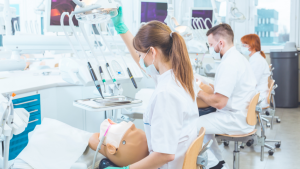Dentists called to shape erosive tooth wear index

UK dentists are being invited to have their say in shaping the evolution of a key diagnostic tool – the Basic Erosive Wear Examination (BEWE).
The BEWE was developed in 2008 as a way for general dentists to screen and record tooth wear. In that time it has become a global tool, used in general practice and research alike.
Now, almost 16 years later, a revised version is under consideration – and the developers need feedback from existing users in order to shape it for the needs of the future.
Help shape the BEWE
To contribute to the survey, simply visit the link below.
The survey should take no more than a minute to complete.
Refining the Basic Erosive Wear Examination
The new version of the BEWE is being spearheaded by Professor David Bartlett and Dr Saoirse O’Toole.
Dr O’Toole said: ‘The BEWE was designed to be a simple tool, similar to the basic periodontal exam (BPE), which can be easily and rapidly incorporated into patient examinations. The use of the BEWE has grown: it is now taught in all schools in the UK and is being adopted globally for both practice and research purposes. Within the UK, it is now embedded in dental softwares such as SOE, Dentally and Epic.
‘However, like any tool, it requires updating. While the BEWE is designed to screen for wear, a BEWE score of three (defect greater than 50% of the surface) covers a broad clinical range. While a score of three is reliable and reproducible it lacks discrimination of severe levels. At the same time, a BEWE score of one (loss of surface texture) is difficult to assess visually without significant training.
‘It is has become necessary to record tooth wear at each patient examination and with this, there may be a need to further refine the BEWE.
‘We are asking for feedback on the BEWE. We would like for you to take one minute to fill in this quick questionnaire to help us shape the BEWE and the way that tooth wear is recorded in the UK.’
Learning more
Dr O’Toole will be presenting a webinar on 1 October titled: ‘Monitoring wear – tools to use now and what we will be using in the future’.
The webinar will examine the different clinical wear indices, explain how to use the BEWE to look for signs of early wear, and take a look at how intraoral scanning can be used as a key diagnostic tool to catch early signs of wear and monitor it in future.
Dr O’Toole is a clinical lecturer at King’s College London Centre for Clinical, Oral and Translational Research. Her clinical area of interest is in erosive tooth wear and dental sleep medicine. Her research focuses on identifying groups at high risk of disease progression and developing diagnostic tools for use in primary care.
She has lectured nationally and internationally on erosive tooth wear with over 40 peer reviewed papers and four book chapters on tooth wear. She has developed a freeware to detect change in sequential 3D intraoral scans and is currently working on her patented device for the intraoral detection of extra-oesophageal reflux.
Professor David Bartlett is head of prosthodontics at the Faculty of Dentistry, Oral & Craniofacial Sciences, King’s College. He is secretary/treasurer for the International Association for Dental Research (IADR) prosthodontic group.
Professor Bartlett has an international reputation as a clinician and researcher and has built a well-known department in clinical science, with a research profile focused on tooth wear and erosion in particular.
He is past president of the international College of Prosthodontics and a member of the Academy of Prosthodontics.







